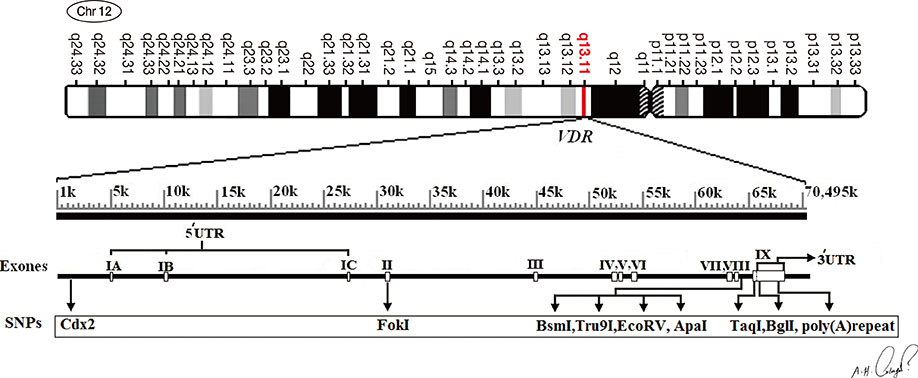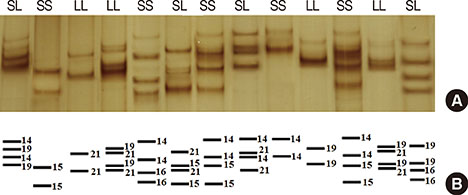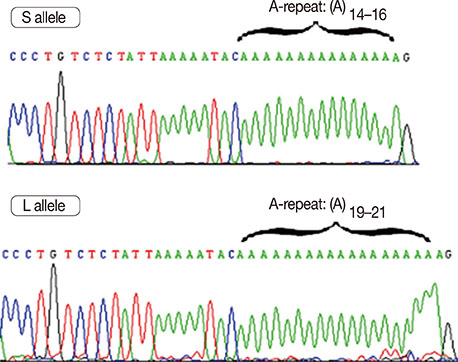J Breast Cancer.
2015 Jun;18(2):119-125. 10.4048/jbc.2015.18.2.119.
Vitamin D Receptor Poly(A) Microsatellite Polymorphism and 25-Hydroxyvitamin D Serum Levels: Association with Susceptibility to Breast Cancer
- Affiliations
-
- 1Department of Molecular and Cell Biology, University of Mazandaran Faculty of Basic Sciences, Mazandaran, Iran. ahcolagar@umz.ac.ir
- 2Department of Clinical Biochemistry, Babol University of Medical Sciences, Babol, Iran.
- KMID: 2374526
- DOI: http://doi.org/10.4048/jbc.2015.18.2.119
Abstract
- PURPOSE
According to previous studies, vitamin D exhibits protective effects against breast cancer via the vitamin D receptor (VDR). There is growing evidence that breast cancer incidence is associated with various polymorphisms of the VDR gene. This study investigates the association of VDR poly(A) microsatellite variants with 25-hydroxyvitamin D (25(OH)D) serum levels and breast cancer risk.
METHODS
Polymorphism analysis was performed on a total of 261 blood samples, which were collected from 134 women with breast cancer and 127 controls. Single strand conformation polymorphism was assessed by polymerase chain reaction in combination with sequencing to detect poly(A) lengths for each sample. The vitamin D levels of samples were determined by electrochemiluminescence.
RESULTS
The poly(A) variant L allele frequency was significantly higher in cancer patients than in controls (odds ratio [OR], 1.73; 95% confidence interval [CI], 1.16-2.57; p=0.006). Thus, carriers of the L allele (LS and LL genotypes) have a higher risk for breast cancer (OR, 1.86; 95% CI, 1.13-3.05; p=0.013). A larger increase in the risk for breast cancer was found in individuals with the L carrier genotype and lowered 25(OH)D levels.
CONCLUSION
The results primarily suggest that VDR gene polymorphism in the poly(A) microsatellite is associated with 25(OH)D levels and that it can affect the breast cancer risk in the female population from northern Iran.
Keyword
MeSH Terms
Figure
Cited by 1 articles
-
Comment to "Vitamin D Receptor Poly(A) Microsatellite Polymorphism and 25-Hydroxyvitamin D Serum Levels: Association with Susceptibility to Breast Cancer"
Salvatore Chirumbolo
J Breast Cancer. 2015;18(4):409-410. doi: 10.4048/jbc.2015.18.4.409.
Reference
-
1. Rezaianzadeh A, Heydari ST, Hosseini H, Haghdoost AA, Barooti E, Lankarani KB. Prevalence of breast cancer in a defined population of iran. Iran Red Crescent Med J. 2011; 13:647–650.2. Naghibi A, Shojaeezade D, Montazeri A, Yazdani J. Early detection of breast cancer among women in Mazandaran, Iran. IJHS. 2013; 1:44–49.
Article3. Taghavi A, Fazeli Z, Vahedi M, Baghestani AR, Pourhoseingholi A, Barzegar F, et al. Increased trend of breast cancer mortality in Iran. Asian Pac J Cancer Prev. 2012; 13:367–370.
Article4. Fang L, Barekati Z, Zhang B, Liu Z, Zhong X. Targeted therapy in breast cancer: what's new? Swiss Med Wkly. 2011; 141:w13231.
Article5. Vogelstein B, Kinzler KW. Cancer genes and the pathways they control. Nat Med. 2004; 10:789–799.
Article6. Beckmann L, Hüsing A, Setiawan VW, Amiano P, Clavel-Chapelon F, Chanock SJ, et al. Comprehensive analysis of hormone and genetic variation in 36 genes related to steroid hormone metabolism in pre- and postmenopausal women from the breast and prostate cancer cohort consortium (BPC3). J Clin Endocrinol Metab. 2011; 96:E360–E367.
Article7. Feldman D, Krishnan AV, Swami S, Giovannucci E, Feldman BJ. The role of vitamin D in reducing cancer risk and progression. Nat Rev Cancer. 2014; 14:342–357.
Article8. Crew KD. Vitamin d: are we ready to supplement for breast cancer prevention and treatment? ISRN Oncol. 2013; 2013:483687.
Article9. Evans RM. The steroid and thyroid hormone receptor superfamily. Science. 1988; 240:889–895.
Article10. Jurutka PW, Whitfield GK, Hsieh JC, Thompson PD, Haussler CA, Haussler MR. Molecular nature of the vitamin D receptor and its role in regulation of gene expression. Rev Endocr Metab Disord. 2001; 2:203–216.11. Thorne J, Campbell MJ. The vitamin D receptor in cancer. Proc Nutr Soc. 2008; 67:115–127.
Article12. Barsony J, Prufer K. Vitamin D receptor and retinoid X receptor interactions in motion. Vitam Horm. 2002; 65:345–376.
Article13. Welsh J, Wietzke JA, Zinser GM, Byrne B, Smith K, Narvaez CJ. Vitamin D-3 receptor as a target for breast cancer prevention. J Nutr. 2003; 133:7 Suppl. 2425S–2433S.
Article14. Miyamoto K, Kesterson RA, Yamamoto H, Taketani Y, Nishiwaki E, Tatsumi S, et al. Structural organization of the human vitamin D receptor chromosomal gene and its promoter. Mol Endocrinol. 1997; 11:1165–1179.
Article15. Köstner K, Denzer N, Müller CS, Klein R, Tilgen W, Reichrath J. The relevance of vitamin D receptor (VDR) gene polymorphisms for cancer: a review of the literature. Anticancer Res. 2009; 29:3511–3536.16. Chakraborty A, Mishra AK, Soni A, Regina T, Mohil R, Bhatnagar D, et al. Vitamin D receptor gene polymorphism(s) and breast cancer risk in north Indians. Cancer Detect Prev. 2009; 32:386–394.
Article17. Ingles SA, Garcia DG, Wang W, Nieters A, Henderson BE, Kolonel LN, et al. Vitamin D receptor genotype and breast cancer in Latinas (United States). Cancer Causes Control. 2000; 11:25–30.18. Whitfield GK, Remus LS, Jurutka PW, Zitzer H, Oza AK, Dang HT, et al. Functionally relevant polymorphisms in the human nuclear vitamin D receptor gene. Mol Cell Endocrinol. 2001; 177:145–159.
Article19. Maurya R, Kumar B, Sundar S. Evaluation of salt-out method for the isolation of DNA from whole blood: a pathological approach of DNA based diagnosis. Int J Life Sci Biotechnol Pharma Res. 2013; 2:53–57.20. Green MR, Sambrook J. Molecular Cloning: a Laboratory Manual. 4th ed. Cold Spring Harbor: Cold Spring Harbor Laboratory Press;2012. p. 104–110.21. Sambrook J, Russell DW. The Condensed Protocols from Molecular Cloning: a Laboratory Manual. Cold Spring Harbor: Cold Spring Harbor Laboratory Press;2006. p. 51–54.22. Mavaddat N, Antoniou AC, Easton DF, Garcia-Closas M. Genetic susceptibility to breast cancer. Mol Oncol. 2010; 4:174–191.
Article23. Valdivielso JM, Fernandez E. Vitamin D receptor polymorphisms and diseases. Clin Chim Acta. 2006; 371:1–12.
Article24. Bretherton-Watt D, Given-Wilson R, Mansi JL, Thomas V, Carter N, Colston KW. Vitamin D receptor gene polymorphisms are associated with breast cancer risk in a UK Caucasian population. Br J Cancer. 2001; 85:171–175.
Article25. McCullough ML, Stevens VL, Diver WR, Feigelson HS, Rodriguez C, Bostick RM, et al. Vitamin D pathway gene polymorphisms, diet, and risk of postmenopausal breast cancer: a nested case-control study. Breast Cancer Res. 2007; 9:R9.
Article26. Trabert B, Malone KE, Daling JR, Doody DR, Bernstein L, Ursin G, et al. Vitamin D receptor polymorphisms and breast cancer risk in a large population-based case-control study of Caucasian and African-American women. Breast Cancer Res. 2007; 9:R84.
Article27. Zhang K, Song L. Association between vitamin D receptor gene polymorphisms and breast cancer risk: a meta-analysis of 39 studies. PLoS One. 2014; 9:e96125.
Article28. Hesketh J. 3'-Untranslated regions are important in mRNA localization and translation: lessons from selenium and metallothionein. Biochem Soc Trans. 2004; 32(Pt 6):990–993.
Article29. Durrin LK, Haile RW, Ingles SA, Coetzee GA. Vitamin D receptor 3'-untranslated region polymorphisms: lack of effect on mRNA stability. Biochim Biophys Acta. 1999; 1453:311–320.
Article30. Tiosano D, Weisman Y, Hochberg Z. The role of the vitamin D receptor in regulating vitamin D metabolism: a study of vitamin D-dependent rickets, type II. J Clin Endocrinol Metab. 2001; 86:1908–1912.
Article
- Full Text Links
- Actions
-
Cited
- CITED
-
- Close
- Share
- Similar articles
-
- Comment to "Vitamin D Receptor Poly(A) Microsatellite Polymorphism and 25-Hydroxyvitamin D Serum Levels: Association with Susceptibility to Breast Cancer"
- Relationship Between Poly (A) Microsatellite in Vitamin D Receptor Gene, and Bone Mineral Density in Postmenopausal Korean Women
- Association between Changes in Serum 25-Hydroxyvitamin D Levels and Survival in Patients with Breast Cancer Receiving Neoadjuvant Chemotherapy
- Association of Serum Vitamin D Levels with Bacterial Load in Pulmonary Tuberculosis Patients
- Pharmacologic supplementation of vitamin D





